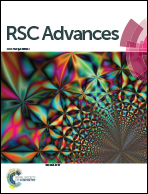Studies on structural, dielectric and optical properties of (Ba0.95Ca0.05)1−x(Ti0.8Sn0.2)1−xNaxNbxO3 lead-free ceramics
Abstract
(Ba0.95Ca0.05)1−x(Ti0.8Sn0.2)1−xNaxNbxO3 (BCNTSNO3) lead-free ceramics with compositions (x = 0.75, 0.8 and 0.85) were synthesized through the traditional solid-state reaction method. X-ray powder diffraction analysis showed the formation of a single phase compound crystallized in tetragonal space group P4mm. The evolution of Raman spectra displayed a disorder introduced into the structure, which favors a ferroelectric relaxor behavior. The dependence of the dielectric properties on temperature exhibited two composition ranges with different behaviors. Ferroelectric relaxor properties were observed for the compositions x < 0.85 and the classical ferroelectric behavior for x = 0.85. Lead free (Ba0.95Ca0.05)1−x(Ti0.8Sn0.2)1−xNaxNbxO3 ceramics exhibited larger dielectric constants than those of parent crystal NaNbO3, suggesting that it is a good candidate for lead-free ceramics in several industrial applications. Using UV-Vis spectroscopy, the optical band gap energy of ceramics (Ba0.95Ca0.05)1−x (Ti0.8Sn0.2)1−xNaxNbxO3 is found at 2.89, 2.92, and 3.05 eV for x = 0.75, 0.8 and 0.85, respectively.



 Please wait while we load your content...
Please wait while we load your content...